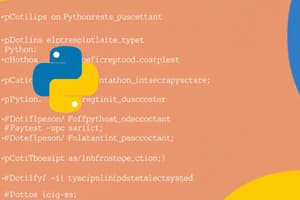Podcast
Questions and Answers
Trong Python, cấu trúc khối được định nghĩa bằng gì?
Trong Python, cấu trúc khối được định nghĩa bằng gì?
Indentation (spaces or tabs)
Số lượng khoảng trắng hoặc tab dùng cho indentation là bao nhiêu?
Số lượng khoảng trắng hoặc tab dùng cho indentation là bao nhiêu?
Tùy ý, nhưng được khuyên dùng 4 khoảng trắng để dễ đọc.
Operator nào được sử dụng để so sánh bằng trong Python?
Operator nào được sử dụng để so sánh bằng trong Python?
==
Dấu hiệu nào được sử dụng để cộng hai giá trị lại trong Python?
Dấu hiệu nào được sử dụng để cộng hai giá trị lại trong Python?
Kiểu dữ liệu nào trong Python là một chuỗi các ký tự?
Kiểu dữ liệu nào trong Python là một chuỗi các ký tự?
Flashcards are hidden until you start studying
Study Notes
Syntax
Indentation
- Python uses indentation (spaces or tabs) to define block-level structure.
- Indentation is used to denote block-level structure, such as in
ifstatements,forloops, andfunctions. - The number of spaces or tabs used for indentation is arbitrary, but it's recommended to use 4 spaces for readability.
Variables and Data Types
- Variables are assigned using the assignment operator (=).
- Python has the following built-in data types:
- Integers (int): whole numbers, e.g.
1,2,3, etc. - Floats (float): decimal numbers, e.g.
3.14,-0.5, etc. - Strings (str): sequences of characters, e.g.
"hello",'hello', etc. Strings can be enclosed in single quotes or double quotes. - Boolean (bool): true or false values
- List (list): ordered collections of items, e.g.
[1, 2, 3],["a", "b", "c"], etc. - Tuple (tuple): ordered, immutable collections of items, e.g.
(1, 2, 3),("a", "b", "c"), etc.
- Integers (int): whole numbers, e.g.
Operators
- Arithmetic operators:
+(addition)-(subtraction)*(multiplication)/(division)**(exponentiation)
- Comparison operators:
==(equal to)!=(not equal to)>(greater than)<(less than)>=(greater than or equal to)<=(less than or equal to)
- Logical operators:
and(logical and)or(logical or)not(logical not)
Control Structures
- Conditional statements:
ifstatement:ifcondition:elifstatement:elifcondition:elsestatement:else:
- Loops:
forloop:forvariableiniterable:whileloop:whilecondition:
Cú pháp Python
- Trong Python, khoảng cách (spaces hoặc tabs) được sử dụng để định dạng cấu trúc khối code.
- Khoảng cách được sử dụng để chỉ định cấu trúc khối code, chẳng hạn như trong các câu lệnh
if,forvà các hàm.
Biến và kiểu dữ liệu
- Biến được gán giá trị bằng cách sử dụng toán tử gán (=).
- Python có các kiểu dữ liệu sau:
- Số nguyên (int): các số nguyên, ví dụ
1,2,3, ... - Số thực (float): các số thập phân, ví dụ
3.14,-0.5, ... - Chuỗi (str): các chuỗi ký tự, ví dụ
"hello",'hello', ... - Boolean (bool): giá trị đúng hoặc sai
- Danh sách (list): các tập hợp các phần tử, ví dụ
[1, 2, 3],["a", "b", "c"], ... - Tuple (tuple): các tập hợp các phần tử không đổi, ví dụ
(1, 2, 3),("a", "b", "c"), ...
- Số nguyên (int): các số nguyên, ví dụ
Toán tử
- Toán tử số học:
+(cộng)-(trừ)*(nhân)/(chia)**(lũy thừa)
- Toán tử so sánh:
==(bằng nhau)!=(không bằng nhau)>(lớn hơn)=(lớn hơn hoặc bằng)
Studying That Suits You
Use AI to generate personalized quizzes and flashcards to suit your learning preferences.




